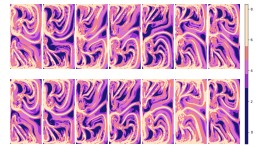Alumnus Kevin Yao ME’18 ME’20 and Prof. Philip Yecko Published in Physics of Fluids
POSTED ON: December 5, 2022

Image: Depicts ocean transport using Finite Time Lyapunov Exponent (FTLE) fields, time increasing to the right, for the actual model ocean flow (top graphic) compared to the ocean predicted by machine learning (bottom graphic).
Cooper Union alumnus Kevin Yao's ME’18 ME’20 recently published “Learning Ocean circulation models with reservoir computing,” in the Physics of Fluids (34, 116604 (2022)). The paper was prepared with Philip Yecko, professor and chair of physics, and Eric Forgoston, a professor with Montclair State University.
Yao has been working in quantitative finance since graduating Cooper. His research studies the application of Reservoir Computing to complex spatio-temporal flows found in several types of ocean models. The most realistic model ocean, known as quasi-geostrophy, is a partial differential equation (PDE) found using an asymptotic approximation of more realistic Navier-Stokes based description. Nevertheless, quasi-geostrophic models realistically capture a number of important oceanic flow regimes and structures and are used in both oceanography and climate studies. The ability of machine learning to predict the behavior of complex PDE systems is important to their use in more complex models of oceans and climates and as an aid to our understanding of ocean transport and flow.
More details and the complete article can be found online here: https://aip.scitation.org/doi/full/10.1063/5.0119061.
ABSTRACT
Two elementary models of ocean circulation, the well-known double-gyre stream function model and a single-layer quasi-geostrophic (QG) basin model, are used to generate flow data that sample a range of possible dynamical behavior for particular flow parameters. A reservoir computing (RC) machine learning algorithm then learns these models from the stream function time series. In the case of the QG model, a system of partial differential equations with three physically relevant dimensionless parameters is solved, including Munk- and Stommel-type solutions. The effectiveness of a RC approach to learning these ocean circulation models is evident from its ability to capture the characteristics of these ocean circulation models with limited data including predictive forecasts. Further assessment of the accuracy and usefulness of the RC approach is conducted by evaluating the role of both physical and numerical parameters and by comparison with particle trajectories and with well-established quantitative assessments, including finite-time Lyapunov exponents and proper orthogonal decomposition. The results show the capability of the methods outlined in this article to be applied to key research problems on ocean transport, such as predictive modeling or control.




